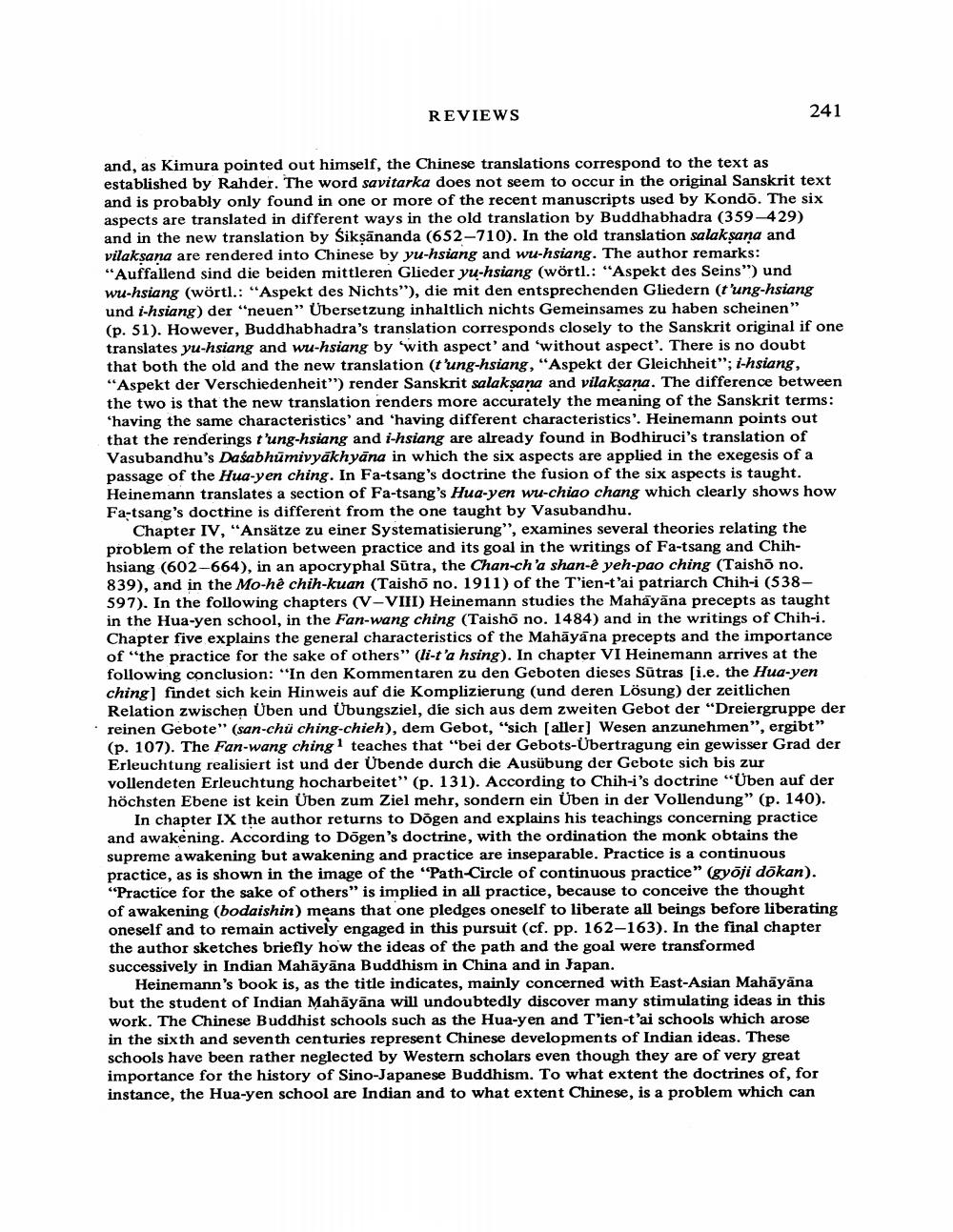________________
REVIEWS
241
and, as Kimura pointed out himself, the Chinese translations correspond to the text as established by Rahder. The word savitarka does not seem to occur in the original Sanskrit text and is probably only found in one or more of the recent manuscripts used by Kondo. The six aspects are translated in different ways in the old translation by Buddhabhadra (359-429) and in the new translation by Śikṣānanda (652-710). In the old translation salakṣana and vilakṣana are rendered into Chinese by yu-hsiang and wu-hsiang. The author remarks: "Auffallend sind die beiden mittleren Glieder yu-hsiang (wörtl.: "Aspekt des Seins") und wu-hsiang (wörtl.: "Aspekt des Nichts"), die mit den entsprechenden Gliedern (t'ung-hsiang und i-hsiang) der "neuen" Übersetzung inhaltlich nichts Gemeinsames zu haben scheinen" (p. 51). However, Buddhabhadra's translation corresponds closely to the Sanskrit original if one translates yu-hsiang and wu-hsiang by 'with aspect' and 'without aspect'. There is no doubt that both the old and the new translation (t'ung-hsiang, "Aspekt der Gleichheit"; i-hsiang, "Aspekt der Verschiedenheit") render Sanskrit salakṣana and vilakṣana. The difference between the two is that the new translation renders more accurately the meaning of the Sanskrit terms: 'having the same characteristics' and 'having different characteristics'. Heinemann points out that the renderings t'ung-hsiang and i-hsiang are already found in Bodhiruci's translation of Vasubandhu's Daśabhumivyakhyāna in which the six aspects are applied in the exegesis of a passage of the Hua-yen ching. In Fa-tsang's doctrine the fusion of the six aspects is taught. Heinemann translates a section of Fa-tsang's Hua-yen wu-chiao chang which clearly shows how Fa-tsang's doctrine is different from the one taught by Vasubandhu.
Chapter IV, "Ansätze zu einer Systematisierung", examines several theories relating the problem of the relation between practice and its goal in the writings of Fa-tsang and Chihhsiang (602-664), in an apocryphal Sutra, the Chan-ch'a shan-ê yeh-pao ching (Taishō no. 839), and in the Mo-hê chih-kuan (Taishō no. 1911) of the T'ien-t'ai patriarch Chih-i (538597). In the following chapters (V-VIII) Heinemann studies the Mahayana precepts as taught in the Hua-yen school, in the Fan-wang ching (Taisho no. 1484) and in the writings of Chih-i. Chapter five explains the general characteristics of the Mahāyāna precepts and the importance of "the practice for the sake of others" (li-t'a hsing). In chapter VI Heinemann arrives at the following conclusion: "In den Kommentaren zu den Geboten dieses Sūtras [i.e. the Hua-yen ching] findet sich kein Hinweis auf die Komplizierung (und deren Lösung) der zeitlichen Relation zwischen Üben und Übungsziel, die sich aus dem zweiten Gebot der "Dreiergruppe der reinen Gebote" (san-chü ching-chieh), dem Gebot, "sich [aller] Wesen anzunehmen", ergibt" (p. 107). The Fan-wang ching1 teaches that "bei der Gebots-Übertragung ein gewisser Grad der Erleuchtung realisiert ist und der Übende durch die Ausübung der Gebote sich bis zur vollendeten Erleuchtung hocharbeitet" (p. 131). According to Chih-i's doctrine "Üben auf der höchsten Ebene ist kein Üben zum Ziel mehr, sondern ein Üben in der Vollendung" (p. 140).
In chapter IX the author returns to Dogen and explains his teachings concerning practice and awakening. According to Dogen's doctrine, with the ordination the monk obtains the supreme awakening but awakening and practice are inseparable. Practice is a continuous practice, as is shown in the image of the "Path-Circle of continuous practice" (gyōji dōkan). "Practice for the sake of others" is implied in all practice, because to conceive the thought of awakening (bodaishin) means that one pledges oneself to liberate all beings before liberating oneself and to remain actively engaged in this pursuit (cf. pp. 162-163). In the final chapter the author sketches briefly how the ideas of the path and the goal were transformed successively in Indian Mahayana Buddhism in China and in Japan.
Heinemann's book is, as the title indicates, mainly concerned with East-Asian Mahāyāna but the student of Indian Mahāyāna will undoubtedly discover many stimulating ideas in this work. The Chinese Buddhist schools such as the Hua-yen and T'ien-t'ai schools which arose in the sixth and seventh centuries represent Chinese developments of Indian ideas. These schools have been rather neglected by Western scholars even though they are of very great importance for the history of Sino-Japanese Buddhism. To what extent the doctrines of, for instance, the Hua-yen school are Indian and to what extent Chinese, is a problem which can




